 Download PDF
Download PDF
Name: Phaseolus polystachios (L.) Britton, Sterns, & Poggenb.
Family: Fabaceae, the Pea Family
Common Names: Bean-vine, thicket bean, wild bean, wild kidney bean (1,13).
Etymology: Phaseolus is the diminutive of the Latin word phaselus, which means kidney-bean. Polys is Greek for many; and stachyos, also Greek, means ear of grain, or spike (4).
Botanical synonyms: Dolichos polystachios L., Phaseolus paniculatus Michx., Phaseolus perennis Walter (1).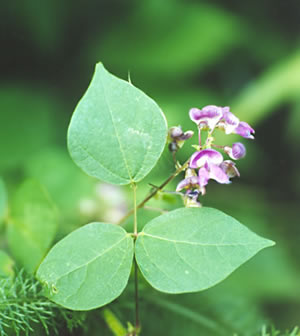
Quick Notable Features (10,12):
¬ Alternate, trifoliolate leaves, pubescent below
¬ Broadly ovate leaflets, acute apex, the apical-most petiolule longer than the others
¬ The raceme is longer than the petiole of the subtending leaf
¬ Pinkish-purple zygomorphic flowers
Plant Height: Usually 1-4m long (5).
Subspecies/varieties recognized (1):
P. polystachios var. aquilonius Fernald
P. polystachios var. polystachios
P. polystachios var. sinuatus (Nutt. ex Torr. & A. Gray) Maréchal, Mascherpa & Stainier
P. polystachios subsp. polystachios
P. polystachios subsp. sinuatus
P. polystachios subsp. smilacifolius (Pollard) Freytag
Most Likely Confused with: Phaseolus vulgaris, Strophostyles helvula, Amphicarpaea bracteata, and Vigna spp.
Habitat Preference: P. polystachios thrives in moist prairies and woods, dry woods, and thickets (10,11).
Geographic Distribution in Michigan: There is only one occurrence of P. polystachios in Michigan. The species was found in Belle Island, Wayne County (2,10).
Known Elevational Distirbution: The species occurs at 137m above sea level in Bollinger, MO (1).
Complete Geographic Distribution: Native to North America. P. polystachios is found in almost every state in the United States east of Texas (AL, AR, CT, DC, DE, FL, GA, IA, IL, IN, KY, LA, MD, ME, MI, MO, MS, NC, NJ, NY, OH, OK, PA, SC, TN, TX, VA, WV), and in Puerto Rico. In Canada, it is found in Ontario. The species also occurs in Mexico (1,6,9).
Vegetative Plant Description: P. polystachios is a perennial trailing or climbing herb with branching, glabrate to finely pubescent stems. The deciduous stipules are lanceolate, the stipels are linear. The leaves are alternate, pinnately compound, and trifoliolate. The leaflets are broadly ovate to orbiculate, entire, apically acute, 2-10.1cm long and 1.5-7.6cm broad, with an excurrent midvein above. The leaflet upper surface is slightly scabrous to glabrous, and the lower is softly pubescent. The two lateral leaflets are asymmetric, with each petiolule shorter than the apical petiolule. The apical leaflet may have a subcordate base (2,5,11,13,14).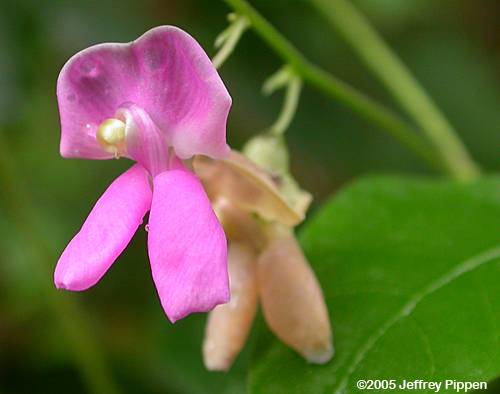
Climbing Mechanism: Apically twining (5), although the orientation of climbing has not been noted in the literature.
Flower Description: The perfect, zygomorphic flowers are borne in many-flowered axillary racemes. The peduncled raceme (10.1-30.5cm long) exceeds the length of the petiole of the subtending leaf, occasionally the whole leaf, and the rachis can be minutely pubescent. Each pink-purple flower (occasionally white) has a 4.2-8.5mm long pedicel and is subtended by 2 bractlets (<1mm). The calyx is 5-parted, the teeth shorter than the 2-2.5mm long tube, and glabrous to densely short pubescent. The corolla (0.8-1.2cm long) is composed of a standard, two wings, and two keel petals. The standard is orbicular and bent, the same length or slightly shorter than the wings. The keel petals are coiled, like in other Phaseolus species, enclosing the reproductive organs. Nine stamens are fused by their filaments and one is free. The single pistil is superior, nearly sessile, and pubescent along the inner side of the persistent style. The stigma in the genus Phaseolus can be oblique or lateral (2,5,11,13).
Flowering Time: July-September (5,11).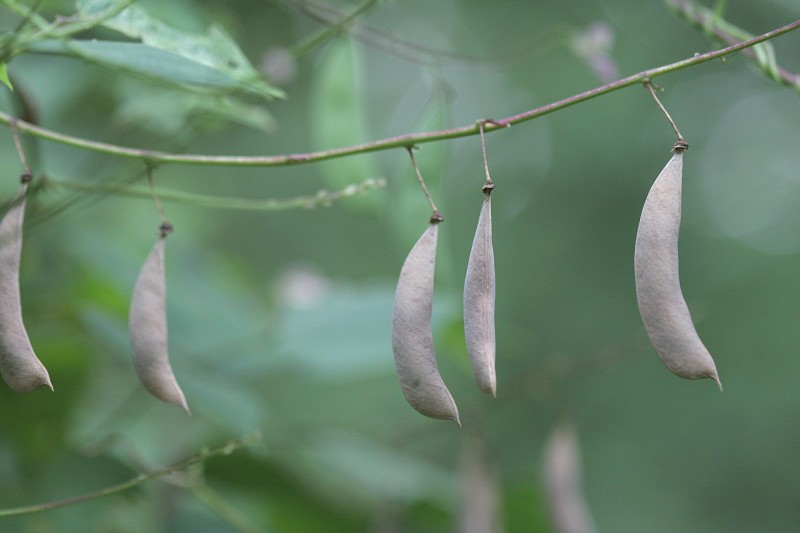
Pollinator: No information was found for P. polystachios, but other members of the genus are pollinated by insects, including honeybees and bumblebees, as well as self-pollinating (15,16).
Fruit Type and Description: The fruit is a glabrous, flat, stipitate legume, 3-8cm long and 0.8-1cm broad, slightly curved. Each legume contains 4-6 seeds (5,11,12).
Seed Description: The small, kidney-shaped seeds are 0.5-1cm long and 0.5-0.6cm wide, smooth and glossy black or black and gray. The hilum is white, 0.3cm x 0.1cm, and oval to oblong. The cotyledons in the genus Phaseolus are thick and suffer very little alteration after germination, remaining above or below the ground (7,11,14).
Dispersal Syndrome: At maturity, the legumes dry and twist open to forcibly expel seeds (7).
Distinguished by: Phaseolus vulgaris, the common bean, usually bears few-flowered inflorescences instead of many-flowered, and its length rarely exceeds the petiole of the subtending leaf, which is not true in P. polystachios. Additionally, the bractlets subtending P. vulgaris flowers are larger than in P. polystachios, being longer than the pedicel. Strophostyles helvula has 2-4mm long linear stipules, which are rarely noted in P. polystachios due to their deciduous nature. Also trifoliolate, the leaflets of S. helvula are slightly lobed, not entire. The racemes have few flowers (up to 10) clustered at the apex, at least the longest tooth in the calyx is longer than the tube, and the keel petals are only curved, not coiled. The seeds in S. helvula are pubescent. Amphicarpaea bracteata is a highly variable species with similar vegetative traits, but a few characteristics such as the leaflets’ midvein not being excurrent can help to differentiate it from P. polystachios. Further, the calyx of A. bracteata has 4 lobes not 5 and while it bears perfect flowers on the racemes, it also bears flowers with absent corolla, and cleistogamous (flower does not open to self-pollinate) at the base of the plant, which produce underground fruits. Vigna spp. are also very similar to P. polystachios, however the inflorescence is a short-raceme with few flowers clustered at the apex, whose keel petals are only slightly curved, not coiled (2,11,13). 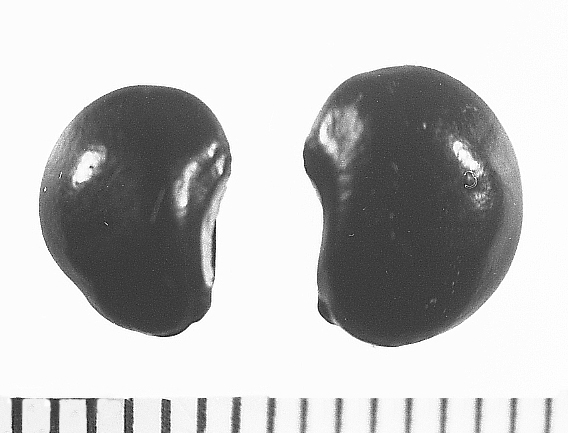
Other members of the family in Michigan: Amorpha (2), Amphicarpaea (1), Anthyllis (1), Apios (1), Astragalus (3), Baptisia (3), Caragana (1), Cercis (1), Chamaecrista (2), Colutea (1), Crotalaria (1), Cytisus (1), Dalea (2), Desmanthus (1), Desmodium (12), Galega (1), Gleditsia (2), Glycine (1), Gymnocladus (1), Hedysarum (1), Hylodesmum (2), Kummerowia (1), Lathyrus (9), Lespedeza (9), Lotus (1), Lupinus (3), Medicago (3), Melilotus (3), Mimosa (1), Orbexilum (1), Phaseolus (1), Pisum (1), Pueraria (1), Robinia (3), Securigera (1), Senna (2), Strophostyles (1), Tephrosia (1), Trifolium (10), Vicia (10), Vigna (1), and Wisteria (2) (source 2).
Ethnobotanical Uses: The seeds are cooked and consumed as a protein source, as a valuable part of Native American’s winter diet. No medical uses are known for P. polystachios (7,8).
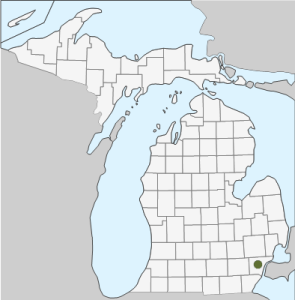 Phylogenetic Information: Phaseolus is a member of the subfamily Faboideae in the Fabaceae family, which is in the order Fabales, part of the Rosids I, Core Eudicots. Members of the Fabaceae family are distributed worldwide, and the family contains approximately 9.4% of all eudicots and 16% of all known woody plants found in neotropical rainforests (3).
Phylogenetic Information: Phaseolus is a member of the subfamily Faboideae in the Fabaceae family, which is in the order Fabales, part of the Rosids I, Core Eudicots. Members of the Fabaceae family are distributed worldwide, and the family contains approximately 9.4% of all eudicots and 16% of all known woody plants found in neotropical rainforests (3).
Interesting Quotation or Other Interesting Factoid not inserted above: The wild bean is listed as a Special Concern species in Connecticut (6). In Michigan, the species is presumed to be extirpated (10). Fritz (1986: 175-177) also identified many P. polystachios beans and their pods in desiccated samples from Ozark rockshelters. Interestingly, the beans from her samples showed possible evidence of human influence. Normally, P. polystachios pods expel the beans by twisting when they are ripe. Many of the pods recovered in her samples, however, while clearly belonging to P. polystachios, were only slightly or not at all twisted. She suggests that pods which did not twist and expel the beans had a selective advantage when humans were doing the dispersal (Fritz 1986: 177).” (7).
Literature and websites used:
- Tropicos.org. Missouri Botanical Garden. 19 Oct 2012 http://www.tropicos.org/Name/13040526
- Michigan Flora Online. A.A. Reznicek, E.G. Voss, & B.S. Walters. February 2011. University of Michigan. Web. October 19, 2012. http://michiganflora.net/species.aspx?id=1338.
- Stevens, P.F. Angiosperm Phylogeny Website. Version 12, July 2012. http://www.mobot.org/mobot/research/apweb.
- Brown, R.W. 1956. Composition of Scientific Words. Washington, D.C.: Smithsonian Institution Press.
- Radford, A.E., H.E. Ahles, & C.R. Bell 1968. Manual of the Vascular Flora of the Carolinas. Chapel Hill, NC: The University of North Carolina Press.
- USDA, NRCS. 2012. The PLANTS Database (http://plants.usda.gov/java/profile?symbol=PHPO2, 10/19/12). National Plant Data Team, Greensboro, NC 27401-4901 USA.
- Schaefer, K. 2009. Laboratory Guide To Archaeological Plant Remains From Eastern North America: Phaseolus polystachios (L.) Britton, Sterns & Poggenb. Department of Anthropology, Washington University in St. Louis. http://artsci.wustl.edu/~gjfritz/Phaseolus_polystachios_%28L.%29_BSP.html
- Core, E.L. 1967. Ethnobotany of the Southern Appalachian Aborigines. Economic Botany 21 (3): 199-214.
- Gbif.org. Global Biodiversity Information Facility Website. Accessed: 24 October 2012.
- Michigan Natural Features Inventory. 2007. Rare Species Explorer (Web Application). Available online at http://mnfi.anr.msu.edu/explorer [Accessed Oct 24, 2012].
- Fernald, M. L. 1950. Gray’s Manual of Botany, 8th ed. New York: American Book Company.
- Gleason, H. A. 1963. Illustrated Flora of the Northeastern United States and Adjacent Canada, Volume 2. New York, NY: Hafner Publishing Company, Inc.
- Britton, N.L. & H.A. Brown 1970. An Illustrated Flora of the Northern United States and Canada: Volume II. New York, NY: Dover Publications, Inc.
- Torrey, J. & A. Gray 1838-1840. A flora of North America: containing abridged descriptions of all the known indigenous and naturalized plants growing north of Mexico; arranged according to the natural system Vol. I. New York, NY: Wiley & Putnam.
- Ibarra-Perez, F.J., N.C. Ellstrand, & J.G. Waines 1996. Multiple paternity in common bean (Phaseolus vulgaris L., Fabaceae). American Journal of Botany 83(6): 749-758.
- Kendall, D.A., & B.D. Smith 1976. The pollinating efficiency of honeybee and bumblebee visits to flowers of the Runner Bean Phaseolus coccineus L. Journal of Applied Ecology 13(3): 749-752.
Image Credits (all used with permission):
1. Image of leaf and raceme courtesy of Bob Zuberbuhler, http://www.westernpawildflowers.com/html/Species.asp?SPID=138&LET=
2. Image of flower courtesy of Jeffrey Pippen, jspippen@duke.edu http://www.duke.edu/~jspippen/plants/phaseolus.htm
3. Image of fruit courtesy of John R. Gwaltney, http://www.southeasternflora.com/view_flora.asp?plantid=82#4. Image of seeds courtesy of Kimberly Schaefer, image found at http://artsci.wustl.edu/~gjfritz/Phaseolus_polystachios_%28L.%29_BSP.html
4. Species distribution map, derived from the Michigan Flora Online.
Primary Author: Cristine V. Santanna, with revisions and editing by John Bradtke and Robyn J. Burnham.
© Robyn J. Burnham
For additional information on Michigan Plant Diversity species accounts, please contact Robyn J. Burnham via email: rburnham“at”umich.edu